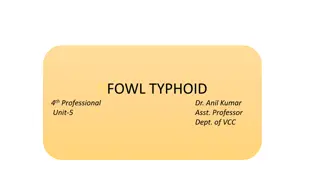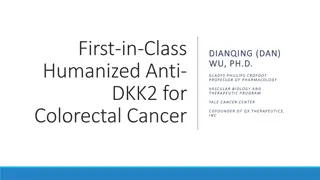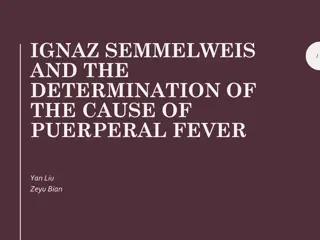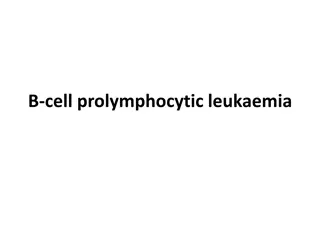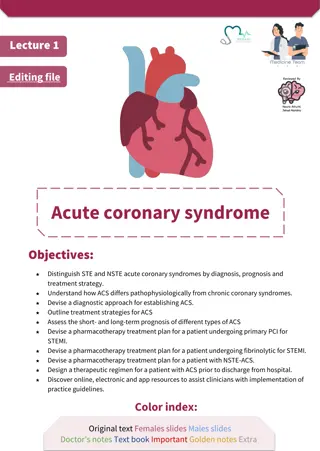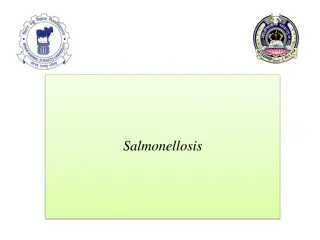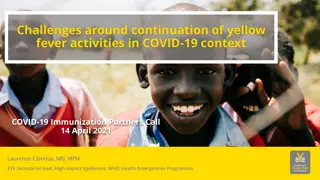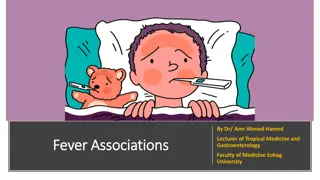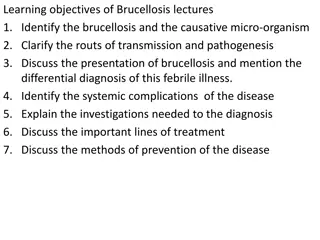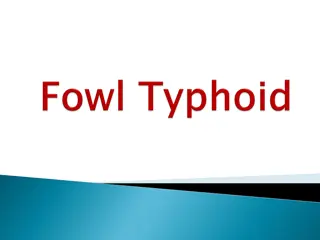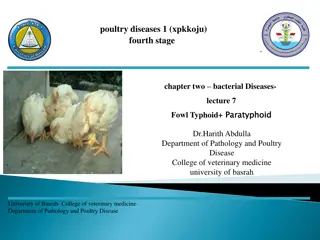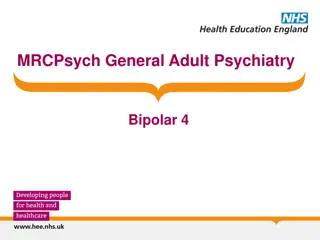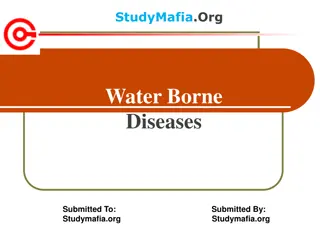Understanding Enteric Fever (Typhoid Fever): Causes, Contagiousness, and Prognosis
Enteric fever, commonly known as typhoid fever, is an acute illness caused by Salmonella typhi bacteria transmitted through contaminated food or water. This fever is highly contagious, with individuals becoming carriers even after recovering. Close contact, contaminated water, and poor sanitation contribute to its spread. With timely antibiotic treatment, most patients recover, but untreated cases can lead to fatalities. Vigilance, proper hygiene, and vaccination are crucial in preventing and managing typhoid fever.
Download Presentation

Please find below an Image/Link to download the presentation.
The content on the website is provided AS IS for your information and personal use only. It may not be sold, licensed, or shared on other websites without obtaining consent from the author. Download presentation by click this link. If you encounter any issues during the download, it is possible that the publisher has removed the file from their server.
E N D
Presentation Transcript
INTRODUCTION Enteric fever,also known as typhoid fever. Typhoid fever is an acute illness associated with fever caused by the Salmonella typhi bacteria. It can also be caused by Salmonella paratyphi, a related bacterium that usually causes a less severe illness. Major cause morbidity and mortality. Food water borne disease. The bacteria are deposited in water or food by a human carrier and then spread to other people.
CAUSE BACTERIA Cause by Bacteria-Salmonella Typhi. Family-Enterobacteriacea. Gram negative bacilii. Best grows at 37 C. TRANSMISSION faecal-oralroute. close contact with patients or carriers. contaminatedwater and food. flies and cockroaches.
Is typhoid contagious? Typhoid fever is highly contagious. An infected person can pass the bacteria out of their body in their stools (faeces) or, less commonly, in their urine. Contamination of the water supply can, in turn, taint the food supply. The bacteriacan survive for weeks in water or dried sewage. How Do People Get Typhoid Fever? Work in or travel to area where typhoid fever is endemic Work as a clinical microbiologist handling Salmonella typhi bacteria Have close contact with someone who is infected or has recently been infectedwith typhoid fever Drink water contaminatedby sewage that contains S. typhi
How Long Is a Person With Typhoid Fever Contagious? A person with typhoid fever is contagious anywhere from days to years (if they become a chronic carrier); some researchers suggest a few individuals may be contagious indefinitely. About 3%-5% of people become carriers of the bacteria after the acuteillness. Others suffer a very mild illness that goes unrecognized. These people may become long-term carriers of the bacteria -- even though they have no symptoms -- and be the source of new outbreaks of typhoid fever for many years.
WhatIs thePrognosis of TyphoidFever? With appropriate antibiotic therapy, most patients recover from the disease. However, 30% of people who do not receive therapy will die. Annually, in the United States, there are about 300-400 cases and only one or two deaths each year. Most of those who gotsick had failed to receive a vaccination prior to travel. Typhoidfever kills hundreds of thousands of people annuallyeach year. Most deaths occur in developing countries where the disease is common. With adequate treatment, less than 1% of victims shoulddie. There is a concernthat multi-antibiotic-resistant strains of bacteria are becomingmore commonworldwide.
PATHOPHYSIOLOGY ( Diarrhoea ) ( onsetof typhoid fever )
What Are the Symptoms of Typhoid Fever? Incubation period is typically about 10-14 days but can be longer, and the onset may be insidious. Symptoms are often non- specific and clinically non- distinguishable from other febrile illnesses. However, clinical severity varies and severe cases may lead to serious complications or even death.
CLINICAL FEATURES Stage 1 (1STWEEK) End of 1STWEEK Slowly rising (stepladder fashion) of temperature for 4-5 days Abdominal pain & myalgia Malaise Headache Constipation Relative bradycardia Rose spots may appear on the upper abdomen & on the back of sparse Cough Splenomegaly Abdominal distension with tenderness Diarrhea Stage 2 (2NDWEEK) Signs and symptoms of 1stweek progress End of 2NDWEEK Delirium, complications, then coma & death (if untreated)
Slightly raised, rose-red spots, which fade on pressure. It is usuallyvisible onlyon white skin
Stage 3 (3RDWEEK) Febrile become toxic & anorexic Significant weight loss Typhoid state (Apathy, confusion & psychosis) High risk (5-10%) of hemorrhage and perforation may cause death Stage 4 (4THWEEK) Recoveryperiod If the individual survives to the fourth week, the fever, mental state, and abdominaldistension slowly improve over a few days. Intestinal and neurologic complications may still occur in surviving untreated individuals. Weight loss and debilitating weakness last months. Some survivors become asymptomatic S typhi carriers and have the potential to transmit the bacteria indefinitely.
Paratyphoidfever The course tends to be shorter and milder than that of typhoid fever and the onset is often more abrupt with acute enteritis. The rash may be more abundant and the intestinal complications less frequent.
Diagnosis &Investigation Bloodculture Specificserologictest IdentifySalmonella antibodies / antigens [ Fluorescent antibody study to look for substances that are specific to Typhoid bacteria ] Widal Testand ELISA UrineandStoolCulture(2nd& 3rdweek) MarrowCulture* - 90% sensitive unless until after 5 days commencementof antibiotic Punch-biopsysamples of rosespots Culture - 63% sensitive Clotculture *culture may be obtained from CSF,peritoneal fluid, mesentericLNs, resected intestine, gallbladder, pharynx,tonsils, abscess, bone
TREATMENT Activity rest is helpful Medical care oAntibiotic oCorticosterois( forsevere typhoid fever) oAntipyretics Diet - fluid and electrolytes should be monitored. Soft digestible diet is preferable in absence of abdominal distension and ileus Surgical care in cases of intestinal perforation
Antibiotic Resistance in many areas of the world, especially India & South-east Asia Chloramphenicol(500mgqid) Ampicillin( 750mg qid) Co-trimoxazole( 2 tablets/iv bds) Fluoroquinolone(Drug of choice) ciprofloxacin(500mg bds) 3rdgenerationcephalosporin ceftriaxone,cefotaxime(alternative) Azithromycin( 500mg oncedaily) alternativewhen fluoroquinolone resistantis present Treatmentshouldbe continuedfor 14 days Chronic carriers were formerly treated for 4 weeks with ciprofloxacin but may requirean alternativeagent and duration,as guidedby antimicrobial sensitivitytesting. Cholecystectomy may be necessary.
Reference Davidson s Principle and Practice of Medicine 22ndEdition Hutchison s Clinical Methods 23rdEdition Medscape MayoClinic Emedicine Health Malaysian Journal of Microbiology [http://mjm.usm.my/uploads/issues/313/Corrected%20proof%20M JM%20475-12%20(ok).pdf]



